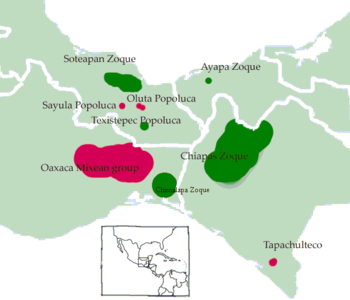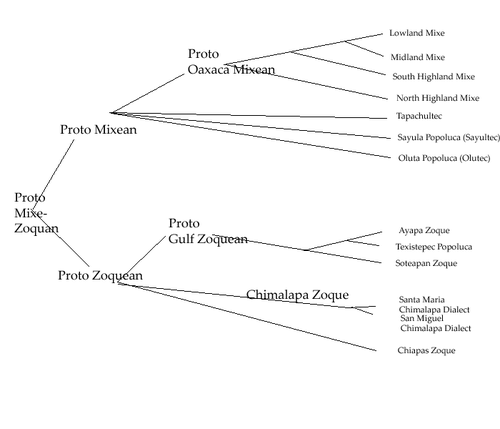- Mixe–Zoque languages
-
Mixe–Zoque Mije–Soke Geographic
distribution:Mesoamerica: Mexico Oaxaca, Chiapas, Tabasco, Veracruz Linguistic classification: Mixe–Zoque. Although some proposals have linked Mixe–Zoquean with other families, none of these has received mainstream acceptance. Proto-language: Proto-Mixe–Zoquean Subdivisions: 
Locations where the Mixe–Zoque languages are spoken: Mixe (red) and Zoque (green)The Mixe–Zoque languages constitute a language family whose living members are spoken in and around the Isthmus of Tehuantepec, Mexico. The Mexican government recognizes three distinct Mixe–Zoquean languages as official: Mixe or ayook with 188,000 speakers, Zoque or o'de püt with 88,000 speakers, and the Popoluca languages of which some are Mixean and some Zoquean with 69,000 speakers. However the internal diversity in each of these groups is great and the Ethnologue counts 16 different languages, and the current classification of Mixe–Zoquean languages by Wichmann (1995) counts 12 languages and 11 dialects. Extinct languages classified as Mixe–Zoquean include Tapachultec, formerly spoken along the southeast coast of Chiapas.
Contents
History
Historically the Mixe–Zoquean family may have been much more widespread, reaching into the Guatemalan Pacific coast (i.e. the Soconusco region). Terrence Kaufman and Lyle Campbell have argued,[1] based on a number of widespread loanwords in other Mesoamerican languages, that it is likely that the Olmec people, generally seen as the earliest dominating culture of Mesoamerica, spoke a Mixe–Zoquean language. Kaufman and John Justeson also claim to have deciphered a substantial part of the text written in Isthmian script (called also by them and some others 'Epi-Olmec') which appears on La Mojarra Stela 1, based upon their deciphering of the text as representing an archaic Mixe–Zoquean language.
Both of these claims have been criticized: Michael D. Coe and David Stuart argue that the surviving corpus of the few known examples of Isthmian inscriptions is insufficient to securely ground any proposed decipherment. Their attempt to apply Kaufman's and Justeson's decipherments to other extant Isthmian material failed to produce any meaningful results. Wichmann (1995) criticizes certain proposed Mixe–Zoquean loans into other Mesoamerican languages as being only Zoquean, not Mixean, which would put the period of borrowing much later than the time-frame in which the Olmec culture was at its height, because during this earlier time Proto-Mixe–Zoquean was a single language.
Later, Kaufman (2001), again on the basis of loans from Mixe–Zoque into other Mesoamerican languages, argues a Mixe–Zoquean presence at Teotihuacan, and he ascribes to Mixe–Zoquean an important role in spreading a number of the linguistic features that later became some of the principal commonalities used in defining the Mesoamerican Linguistic Area.
Mixe–Zoque is not thought to be related to any other language-group, though in the early 20th century Edward Sapir included it as a member of his proposed Penutian linguistic superfamily, and it has recently been included in a Toto-Zoquean proposal.
The branches of the Mixe–Zoque language family are as follows:
Genealogy
The classification of Mixe–Zoquean languages made by Søren Wichmann (1995):
Phonology
The phoneme inventory of Proto-Mixe–Zoquean as reconstructed by Wichmann (1995) can be seen to be relatively simple, but many of the modern languages have been innovative, and some have become quite vowel rich, and some also have introduced a fortis/lenis contrast in the stop-series. Although the lateral phoneme /l/ is found in a few words in some of the languages, these are probably of onomatopoeic origin.
Front Central Back Close
(high)*i *iː *ɨ *ɨː *u *uː Mid *e *eː *o *oː Open
(low)*a *aː *ɨ *ɨː has also been reconstructed *ə *əː.
Bilabial Alveolar Alveolo-Palatal Velar Glottal Stops *p *t *ts *k *ʔ Fricatives *s *h Nasals *m *n Approximants *w *j Syllables
Mixe–Zoquean languages are characterized by complex syllabic nuclei made up of combinations of vowels together with the glottal stop and /h/ in the protolanguage. Complex syllable-final consonant-clusters are also typical in the daughter languages and can be reconstructed for the protolanguage.
Proto-Mixe–Zoquean syllable nuclei could be either:
- V – short vowel
- V' – short vowel with glottal stop
- VV – long vowel
- V'V – long vowel with medial glottal stop
- VV' – long vowel with final glottal stop
- Vh – short vowel with h
Grammatical features
The Mixe–Zoquean languages are head-marking and polysynthetic, with morphologically complex verbs and simple nouns. Grammatical subjects as well as objects are marked in the verb. Ergative alignment is used, as well as direct–inverse systems triggered by animacy and topicality. In Mixe–Zoquean verbs, a morphological distinction is made between two basic clause-types, independent and dependent; verbs take different aspectual and personal affixes, depending on the type of clause in which they appear. There are two different sets of aspect-markers, one used in dependent clauses and another used in independent clauses. Three aspects are distinguished within each clause-type: incompletive, completive, and irrealis.
Ethnologue classification and SIL ISO-codes
Ethnologue still uses the earlier pre-Wichmann classification as a basis for their work.
- Mixe languages — an estimated 90,000 native speakers
- Eastern Mixe — An estimated 72,000 native speakers
- Veracruz Mixe — An estimated 4,000 native speakers
-
- Dialects: Oluta (plo) nearly extinct – only 100 speakers, Sayula (pos)
- Western Mixe
-
- An estimated 10,000 native speakers
- Dialects: Totontepec (mto), Tlahuitoltepec (mxp)
- Zoque languages — an estimated 60,000 native speakers
- Chiapas Zoque — An estimated 22,000 native speakers
- Oaxaca Zoque – An estimated 4,500 native speakers
-
- Dialect: Chimalapa (zoh)
- Veracruz Zoque — An estimated 30,000 native speakers
-
- Dialects: Highland (poi), Texistepec (poq) nearly extinct – only 450 speakers, Tabasco (zoq) nearly extinct – only 40 speakers
Notes
- ^ Campbell and Kaufman (1976).
References
- Campbell, L., and T. Kaufman (1976), "A Linguistic Look at the Olmecs", American Antiquity, 41 pp. 80–89.
- Justeson, John S., and Kaufman, Terrence, (1997),"A Newly Discovered Column in the Hieroglyphic Text on La Mojarra Stela 1: a Test of the Epi-Olmec Decipherment", Science, 07/11/97, Vol. 277 Issue 5323, p. 207.
- Justeson, John S., and Kaufman, Terrence (2001) Epi-Olmec Hieroglyphic Writing and Texts.
- Kaufman, Terrence, (2001) Nawa linguistic prehistory, published at website of the Mesoamerican Language Documentation Project
- Wichmann, Søren (1995). The Relationship Among the Mixe–Zoquean Languages of Mexico. Salt Lake City: University of Utah Press. ISBN 0-87480-487-6.
- Wichmann, Søren (1998). "A conservative look at diffusion involving Mixe–Zoquean languages". In Roger Blench and Matthew Spriggs (eds.). Archaeology and Language, vol. II: Correlating archaeological and linguistic hypotheses. One World Archaeology series, no. 29. London and New York: Routledge. ISBN 0-415-11761-5. OCLC 35673530.
- Brigham Young University press release on behalf of Brigham Young University archaeologist Stephen Houston and Yale University professor emeritus Michael Coe disputing Justeson/Kaufman findings.
External links
- Mixe–Zoque entry at Ethnologue
- Mixe–Zoque language family
Mixe–Zoque languages Mixe Oaxaca MixeCoatlán Mixe, Isthmus Mixe, Totontepec Mixe, Tlahuitoltepec Mixe, Juquila Mixe, Mazatlán Mixe, North Central Mixe, Quetzaltepec MixeGulf MixeChiapas MixeTapachultec†Zoque Oaxaca ZoqueChimalapa ZoqueChiapas ZoqueCopainalá Zoque, Rayón Zoque, Francisco León ZoqueGulf ZoqueHighland Popoluca, Texistepec Popoluca, Tabasco Zoque† – Extinct.Categories:- Mesoamerican languages
- Language families
- Indigenous languages of Mexico
Wikimedia Foundation. 2010.

